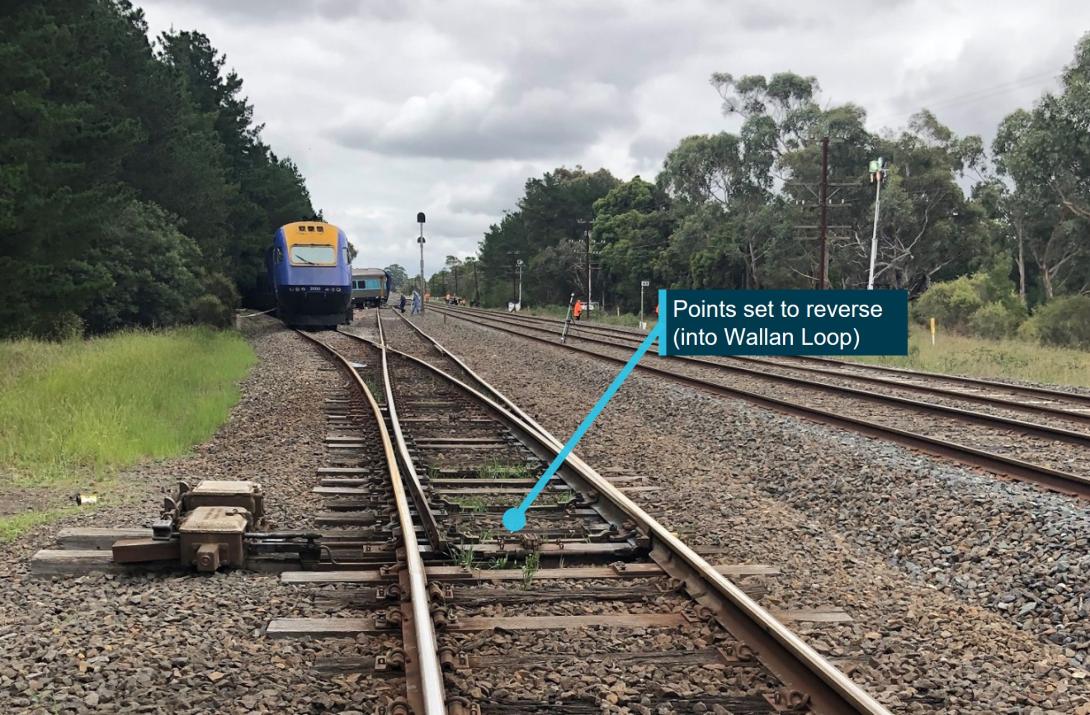
A breakdown in risk management processes contributed to the derailment of an XPT passenger train at Wallan, Victoria, a transport safety investigation report has found.
NSW Trainlink XPT passenger train ST23 was operating a service from Sydney to Melbourne on 20 February 2020 when it derailed entering a crossing loop at a speed of between 114 and 127 km/h, when the maximum permitted speed to enter the loop was 15 km/h.
The train’s leading power car overturned and slid on its side before coming to rest, and the driver and an accompanying qualified worker (who was in the power car alongside the driver to manage activation of a level crossing) did not survive the accident. Eight passengers were admitted to hospital with serious injuries, while a reported 53 passengers and the 5 passenger service crew sustained minor injuries.
An ATSB transport safety investigation into the accident, led by Victoria’s Chief Investigator, Transport Safety, and supported by the New South Wales Office of Transport Safety Investigations (OTSI), details 37 findings including 15 safety issues (an organisational or systemic safety factor with an identified on-going risk to safety).
The investigation details that a fire in a signalling hut earlier in the month meant that rail infrastructure manager ARTC had put in place administrative arrangements where train authority documents (paper forms) gave train drivers permission to travel through a 24 km section of track between Kilmore East and Donnybrook section while the signalling system was inoperative.
At Kilmore East, where the AQW also boarded the train, the driver of ST23 was provided with a modified train authority document that included information on the routing of the train through Wallan Loop.
Trains were being sent through Wallan loop on 20 February to remove contaminants from the track prior to testing of repairs to the signalling system.
“In the 12 days prior to the accident, the driver had operated the XPT service through Wallan 8 times, and on all occasions the crossing loop was locked out of service, this has led us to believe they probably expected to remain on the straight track, where the speed limit was 130Km/h through Wallan,” said ATSB Chief Commissioner Angus Mitchell.
“However, there was no protocol in place to confirm the driver’s understanding of the revised instruction, with no requirement for the driver to read back or confirm the instructions to the network control officer.”
Train working arrangements to manage traffic while the signalling system was not functioning deviated from ARTC network rules and there was ineffective management of the risks introduced by this deviation, the investigation found.
“We identified that several safety factors increased safety risk including weaknesses in ARTC risk management, the train working arrangements, risk controls including a reliance on manual processes, and stakeholder engagement,” said Chief Investigator, Transport Safety, Mark Smallwood.
“There were several available and practical risk controls that were not used, and there continues to be a high reliance on administrative controls and a slow take up of technological solutions by the rail infrastructure manager to improve safety.”
The investigation also highlighted that the design of the XPT driver’s cab contributed to the adverse outcome for the driver and accompanying qualified worker, and that passenger briefings, onboard guides and signage did not provide a reasonable opportunity for all passengers to have knowledge of what to do in an emergency.
The investigation also found that NSW Trains did not have a functioning process for obtaining safety critical information for its Victorian operations from the ARTC web portal.
“Critical to successful risk management in degraded network conditions is the involvement of network users in the identification and assessment of emergent risks, and user participation in the development of appropriate risk controls,” said Mr Smallwood.
“This investigation highlights the importance of effective risk management for managing planned and unplanned track and infrastructure works, such as in this instance the loss of signalling through Wallan.”
Concluded Mr Mitchell: “There was an over reliance on administrative controls and the missed opportunities to use existing and emerging technologies to manage risk associated with human error.
“To improve safety outcomes, the rail sector must move faster and together in embracing technology to improve its management of safety risks.”
Read the report: Derailment of passenger train ST23, Wallan, Victoria, on 20 February 2020


